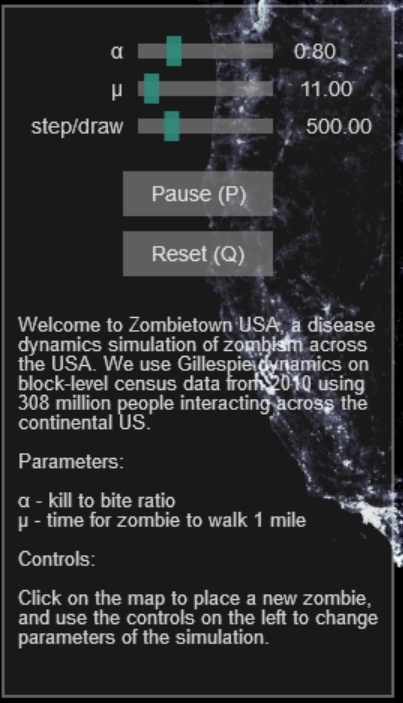Simulate a zombie outbreak

I’m a big fan of zombie movies, and have been for decades. They are an interesting and varied examination of how humans would behave in extraordinary circumstances. However they are also a practical yet fun method for evaluating the propagation of disease and epidemics, something we have seen with issues like bird flu and measles.
Of course, a zombie outbreak has novel aspects that have to be considered, separately from other outbreaks. For example, according to canon, being bitten by a zombie means you will turn into one yourself. It might take a while, but it will happen. There are other issues; zombies are easy to see and will actively seek out other humans, yet they are subject to ailments of their own such as rigor mortis and the impact of vectors that would seek to feed on them as well, such as flies and what have you.
In order to determine how a zombie outbreak might propagate as a model that could be expanded to other diseases, researchers at Cornell University have authored a paper titled “You Can Run, You Can Hide: The Epidemiology and Statistical Mechanics of Zombies” (pdf can be read here) that evaluates how an outbreak might propagate based on their SZR model; S represents humans, Z represents zombies, and R represents zombies that have been, shall we say, ‘dealt with.’ It’s a take on the traditional SIR, or Susceptible-Infected-Recovered model used for more realistic diseases and outbreaks.
It’s a fun read, but here’s the best part: To support their conclusions, they have created an online zombie-outbreak simulator, which allows you to set some initial parameters then place a single zombie, and watch the fun spread. By fun I mean zombie outbreak.
Some outbreaks stop before they can begin. A zombie on the outskirts of Broken Bow, Nebraska, will have little effect. Orlando, however, or New York City or Los Angeles will wreak havoc. Not only have they made the simulator, they have made all the underlying code available for you to peruse over at GitHub, a code-hosting website.
I have to make some comments about the settings, however, in that I feel they don’t explain what any of them actually mean.
For example, they state that α = kill to bite ratio, but don’t state what it means (how many zombies are killed versus how many people are bitten), only stating that the .80 value to which the simulator defaults is representative of the movies “Night of the Living Dead,” the 1968 original that started it all which you can watch here in full HD, and “Shaun of the Dead.” They also state that the .80 value means “zombies are 1.25 times more effective at biting humans than humans are at killing zombies (Pg. 9)” They did improve the definition of μ, indicating it’s the “time for a zombie to walk 1 mile,” as opposed to the previous definition of “Inter-cell propagation.” I believe “Step/Draw” indicates a time delay of how often the propagation is re-calculated and drawn onto the map.
Anyway, it’s all quite fascinating. Starting in Florida I manged to infect the whole east coast in a little over a day, whereas in southern Nevada the apocalypse never got off the ground. Let’s see if we can take over the country!


